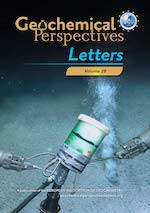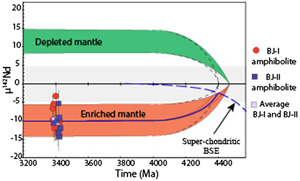 | Rare evidence for the existence of a Hadean enriched mantle reservoir Abstract: Short lived isotopic systems can help unravel the complex early differentiation history of the Earth’s mantle. Excesses in neodymium-142 (142Nd) measured in several occurrences of Archean mantle-derived rocks, compared to the modern upper mantle, imply the formation of an early depleted mantle in the Hadean. However, the existence of a complementary enriched reservoir, which should have also stemmed from such early differentiation event, remains equivocal. New data on 3.4 billion year old amphibolites from the São José do Campestre Massif, NE Brazil, show well resolved 142Nd deficits compared to the modern upper mantle, down to −14.1 ppm. This provides the first clear evidence for an early enriched mantle source, which may represent the missing concomitant reservoir complementary to Earth’s early depleted mantle. |
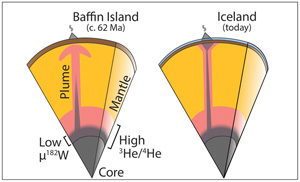 | Tungsten isotopes in Baffin Island lavas: Evidence of Iceland plume evolution Abstract: Tungsten and helium isotope ratios in lavas derived from deeply rooted mantle plumes are tracers of lower mantle compositional heterogeneity or core–mantle exchange. We measured the tungsten isotopic compositions of lavas with exceptionally high-3He/4He ratios that erupted above the head of the Iceland plume on Baffin Island. These lavas have 182W/184W ratios that are indistinguishable from the convecting upper mantle, unlike younger lavas in Iceland that have lower 182W/184W ratios. This implies that only the Iceland plume tail was infused with low-182W/184W material, likely from the core. If high-3He/4He helium also comes from the core, then diffusion across the core–mantle boundary may stratify plume-source mantle domains, with elevated 3He/4He travelling farther into the lower mantle than 182W/184W anomalies. Over Earth history, tungsten diffusion from the core can explain the decline of 182W/184W in the convecting mantle. We speculate that the uneven pace of this decline corresponds with evolving lower mantle dynamics. |
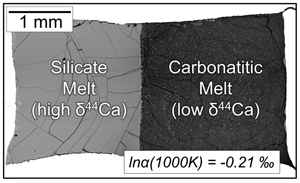 | Calcium isotope fractionation during melt immiscibility and carbonatite petrogenesis Abstract: Stable calcium isotopes have been used to suggest that subducted marine carbonates are frequently involved in the formation of carbonatites. Significant Ca isotope fractionations during carbonatite petrogenesis, however, could lead to a dramatically different picture. We present Ca isotope data for (i) coexisting (immiscible) carbonatite and silicate melts from high temperature centrifuging piston cylinder experiments, (ii) primary apatite and calcite/dolomite from natural carbonatites, and (iii) ab initio estimates for equilibrium Ca isotope partitioning in calcite, dolomite, and ankerite. Carbonatitic melts have lower δ44Ca than their conjugate silicate melts, with an equilibrium fractionation factor [1000lnα(1000K)] of −0.21 ± 0.06 (tSE). We develop a quantitative four stage model for carbonatite petrogenesis (partial melting followed by fractional crystallisation, silicate-carbonatite melt immiscibility, and calcite/apatite accumulation) that fully explains our natural data (average δ44CaBSE of −0.30 ± 0.03 ‰) and those from recent studies, without requiring isotopic contributions from recycled marine carbonates. Our results suggest that lighter isotopes of similarly bound cations (e.g., Mg, Fe, Sr, Ba, Zn) should be preferentially incorporated into carbonatitic melts and that calciocarbonatite formation involves melt immiscibility after differentiation of mantle-derived alkaline CO2-bearing silicate melts. |
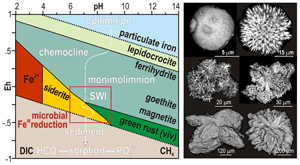 | Authigenic minerals reflect microbial control on pore waters in a ferruginous analogue Abstract: Ferruginous conditions prevailed in the oceans through much of Earth’s history. However, minerals recording these conditions remain difficult to interpret in terms of biogeochemical processes prior to lithification. In Lake Towuti, Indonesia, ferruginous sediments are deposited under anoxic sulfate-poor conditions similar to the Proterozoic oceans, allowing the study of mineralogical (trans)formations during microbial diagenesis. Comprehensive pore water geochemistry, high resolution geochemical core profiles, and electron microscopy of authigenic minerals revealed in situ formation of magnetite, millerite, and abundant siderite and vivianite along a 100 m long sequence. Framboidal magnetites represent primary pelagic precipitates, whereas millerite, a sulfide mineral often overlooked under sulfate-poor conditions, shows acicular aggregates entangled with siderite and vivianite resulting from saturated pore waters and continuous growth during burial. These phases act as biosignatures of microbial iron and sulfate reduction, fermentation and methanogenesis, processes clearly traceable in pore water profiles. Variability in metal and organic substrates attests to environment driven processes, differentially sustaining microbial processes along the stratigraphy. Geochemical profiles resulting from microbial activity over 200 kyr after deposition provide constraints on the depth and age of mineral formation within ferruginous records. |
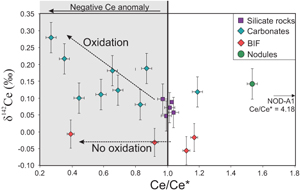 | Stable cerium isotopes as a tracer of oxidation reactions Abstract: Redox conditions in past oceans have attracted significant interest and many proxies have been used to probe redox changes through time. For example, the redox dependent behaviour of Ce, resulting in negative or positive elemental Ce anomalies, has been widely used. More recently, mass dependent Ce isotopic variations have been proposed as a powerful tool to study Ce oxidation in natural environments. In this study, we demonstrate, for the first time, that Ce isotopes are fractionated during oxidation reaction, confirming the utility of Ce isotopes to study redox reactions. This result suggests that seawater Ce isotopic composition should be fractionated toward heavy values relative to the continental crust. Measured natural rock samples (carbonates, banded iron formations and Mn nodules) have variable Ce isotopic compositions, ranging from −0.055 ± 0.045 ‰ to +0.280 ± 0.045 ‰. The relation between Ce elemental anomalies and Ce isotopic composition in carbonate rocks suggest that mass dependent Ce isotopes can be used to distinguish elemental anomalies produced by oxidation reactions from those produced by other processes. Coupled with La-Ce chronology, mass dependent Ce isotope analysis is a very powerful tool to study redox reactions in past oceans. |
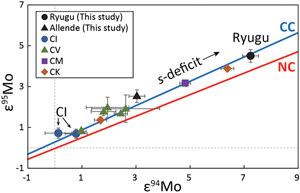 | Nucleosynthetic s-Process Depletion in Mo from Ryugu samples returned by Hayabusa2 Abstract: Initial analyses of samples collected from two locations on the asteroid Ryugu indicated that the mineralogical, chemical, and isotopic characteristics of the Ryugu samples show similarities to carbonaceous chondrites, particularly the Ivuna-type (CI) group. In this study, we analysed a composite sample of four bulk Ryugu samples (A0106, A0106-A0107, C0107, and C0108) collected from both sampling locations that were combined in order to determine its mass independent Mo isotopic composition and reveal contributions from diverse nucleosynthetic sources. The ɛ94Mo and ɛ95Mo values for the Ryugu sample are characterised by the carbonaceous chondrite (CC)-type, which is consistent with the nucleosynthetic isotope compositions observed for other elements (Cr, Ti, Fe, and Zn). The Ryugu composite sample, however, is characterised by greater s-process depletion of Mo isotopes compared with any known bulk carbonaceous chondrite, even including CI chondrites. The observed Mo isotopic signature in the Ryugu composite was most likely caused by either incomplete digestion of s-process-rich presolar SiC, or biased sampling of materials enriched in aqueously-formed secondary minerals characterised by s-process-poor Mo isotopes, resulting from the physicochemical separation between s-process-rich presolar grains and a complementary s-process-poor aqueous fluid in the Ryugu parent body. |
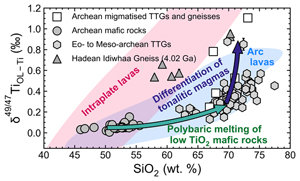 | Titanium isotope constraints on the mafic sources and geodynamic origins of Archean crust Abstract: The timing and formation of Earth’s first continents during the Archean are subjects of significant debate. By examining titanium isotope variations in Archean Tonalite-Trondhjemite-Granodiorite (TTG) rocks and using advanced thermodynamic modelling, we can narrow down the processes involved and emphasise the role of mafic precursor compositions. In our study of Eoarchean Isua metabasalts and Itsaq tonalites in southern West Greenland, we observed a pattern of increasing Ti isotope enrichment with higher SiO2 content, resembling the compositions found in modern subduction zone rocks. Our modelling suggests that the Ti isotope variations in TTGs can be best explained by a combination of partial melting of low TiO2 metabasalts and subsequent crystallisation of tonalitic magmas, resulting in heavier Ti isotopes. This means that Ti isotopes help us distinguish the contributions of various mafic sources and fractional crystallisation during TTG formation. In the case of Itsaq tonalites and many other Eoarchean TTGs, low TiO2 tholeiitic metabasalts with arc-like characteristics likely represent the mafic source rocks, suggesting the formation of some of Earth’s earliest continental crust within a proto-subduction zone setting. |
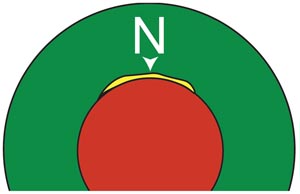 | Magnesiowüstite as a major nitrogen reservoir in Earth’s lowermost mantle Abstract: Ferropericlase (Mg,Fe)O is after bridgmanite the most abundant phase in the lower mantle. The ultralow velocity zones above the core-mantle boundary may contain very Fe-rich magnesiowüstite (Fe,Mg)O, possibly as result of the fractional crystallisation of a basal magma ocean. We have experimentally studied the solubility of nitrogen in the ferropericlase-magnesiowüstite solid solution series as function of iron content. Multi-anvil experiments were performed at 20–33 GPa and 1600–1800 °C in equilibrium with Fe metal. Nitrogen solubility increases from a few tens ppm (μg/g) for Mg-rich ferropericlase to more than 10 wt. % for nearly pure wüstite. Such high solubilities appear to be due to solid solution with NiAs-type FeN. Our data suggest that during fractional crystallisation of a magma ocean, the core-mantle boundary would have become extremely enriched with nitrogen, such that the deep mantle today could be the largest nitrogen reservoir on Earth. The often discussed “subchondritic N/C” ratio of the bulk silicate Earth may be an artefact of insufficient sampling of this deep reservoir. |
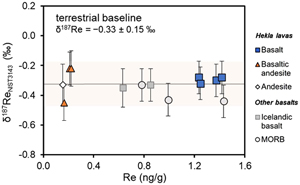 | Rhenium elemental and isotopic variations at magmatic temperatures Abstract: Recent analytical advances in the measurement of rhenium (Re) isotope ratios allow its potential as a palaeoredox and chemical weathering proxy to be explored. However, a successful isotopic proxy must be grounded by an understanding of its composition and behaviour in the solid Earth. Here, we present Re concentrations and Re isotopic (δ187Re) compositions for a well-characterised sequence of lavas from Hekla volcano, Iceland. The concentration of Re varies from 0.02 to 1.4 ng/g, decreasing from basalt to more evolved lavas. We show that the crystallisation and removal of magnetite is responsible for the Re decrease in this system. By contrast, δ187Re values for the same suite of samples show a relatively narrow range (−0.45 to −0.22 ‰), suggesting minimal resolvable Re isotope fractionation between magnetite and the silicate melt. Together with other samples, including mid-ocean ridge basalts, these first igneous data can be used to estimate a baseline for terrestrial materials (δ187Re = −0.33 ± 0.15 ‰, 2 s.d., n = 14), from which low-temperature Re isotope variations in Earth’s surficial environments can be assessed, alongside the global isotope mass balance of Re. |
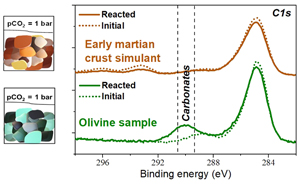 | The key role of bedrock composition in the formation of carbonates on Mars Abstract: Martian carbonates are fundamental minerals for understanding the geochemical and climatic evolution of the planet and the search for potential life, representing one of the key objectives for the Perseverance rover at Jezero Crater. However, the scarcity of carbonate reservoirs on the surface compared to the extent of terrestrial carbonates questions whether these carbonates are indicators of past surface conditions or products from deeper processes unrelated to martian climate. We investigate the formation of carbonates by surface weathering under a CO2 atmosphere in a suite of individual minerals and martian simulants based on the early Mars crust composition. We identify the formation of magnesium carbonates in olivine-bearing samples, but not in the early martian crust simulants. These findings are consistent with the association of carbonates with olivine-rich substrate detected on Mars and highlight the role of the substratum composition in the distribution of carbonates formed by surface processes. Hence, we conclude that the limited surface reservoirs of carbonate are reconcilable with the existence of a CO2-rich atmosphere on early Mars. |
<< Previous issueNext issue >>





